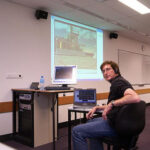
- Image via Wikipedia
The notion of virtual distance seems to be a multi-faceted one. In Bring Virtual Distance into Focus* the authors (Lojeski and Yuva) identify geographical distance as only one of the dimensions of virtual distance. The other dimensions, operational distance and affinity distance, seem to have far greater impact on the feasibility of remote operation – be it in education or business/industry.
The article discusses a business model that can easily be translated into guidelines for an educational model. They suggest that many managers, like many teachers/academics, are somewhat habituated into co-location and as such tend to look to proximity (physical distance) as the key limiter of effectiveness and engagement. My experience is that many teachers also proclaim that the really exciting work they do with students can only be done within the synchronous geographical confines of a classroom.
Lojeski and Yuva suggest that the operational and affinity dimensions need to be adequately addressed. They suggest that “leaders should also expand their roles by becoming social enablers who ensure that employees know each other” – I’d suggest that this is exactly what teachers/academics in blended flexible learning environments also need to address.
No-one is asking educators to become shadchan but rather to think about the nature of teaching and learning activities that they employ. By establishing mechanisms for social engagement and learning activities that draw learners together the best educators are readily able to address virtual distance.
Examples are provided (from the IBM model and another from Rite Solutions) to show how businesses can effectively utilise social networking strategies that foster employee engagement and participation, regardless of where they are physically located.
The solution proposed in the article is pinned to addressing these elements:
- creating a single point of idea and communication exchange open to all employees;
- encouraging employee support for projects which address personal and professional interests; and
- promoting collaboration and relationship-building.
– not unsurprising really, but these are the very factors that are so often overlooked when educators believe that they have no role to play in facilitating distance education. Information is everywhere so the single channel use of LMS as delivery systems is difficult ot justify. Subject expertise alone is not enough – educators must be people people, and must know how to draw people together across physical distance.
Effective activity choice is one key element – setting a common essay topic and sitting back until all students submit is no longer an acceptable approach to flexible learning. The learning (and arguably assessment) tasks/activities must address these elements of operation and affinity. Co-creation of artifacts is one simple approach, utilising online tools that naturally (or artificially) engage is another… and synchronous engagement is not a prerequisite… many activities can be conducted collaboratively and socially despite time zones and personal schedules. Discussion boards, forums, microblogging, tagging communities, bookmarking communities, comment communities can all be leveraged to bring learners and teachers together in a vibrant dynamism that enlivens and socialises learning.
Other information on similar themes:
Making Virtual Distance Work in the Digital Age A IIIP Whitepaper
*Lojeski, K.S. and Yuva, J. (2008) Bring Virtual Distance into Focus in Inside Supply Management, October 2008, pp. 26-29
Related articles by Zemanta
- Reasons Why People Prefer Online Social Network!
- What is Online Learning?
- UW students develop new online social networking technology
- Synchronous Learning Tools
![Reblog this post [with Zemanta]](http://img.zemanta.com/reblog_a.png?x-id=f69c00f0-7246-4167-be54-f4dccfa14aad)






2 thoughts on “Managing “Virtual Distance”: an educational perspective.”